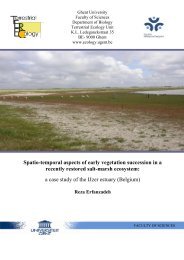PhD Arthur Decae 2010 - Ghent Ecology - Universiteit Gent
PhD Arthur Decae 2010 - Ghent Ecology - Universiteit Gent
PhD Arthur Decae 2010 - Ghent Ecology - Universiteit Gent
Create successful ePaper yourself
Turn your PDF publications into a flip-book with our unique Google optimized e-Paper software.
Material & Methods<br />
The material studied consisted of a sample of 36 Ummidia specimens (23 female + 13 male).<br />
14 females and 11 males were recently collected from southern parts of the Iberian Peninsula<br />
both in Spain and in Portugal. Nine females from North Africa and one male from Spain<br />
(Cartagena) were found in Simon’s collection at the Museum National d’ Histoire Naturelle<br />
(MNHN) in Paris and a single male from Spain was found in the collection of the British<br />
Museum Natural of History (BMNH) London. Although not explicitly stated on the tube<br />
labels, type specimens of Actinopus (Ummidia) algerianus (Lucas 1846) and Pachylomerus<br />
(Ummidia) occidentalis (Simon 1909) were probably among the material studied in Paris.<br />
Further relevant information was obtained through the kind cooperation of the Oxford<br />
University Museum (OUM) that provided photographs of the dried type specimens of<br />
Actinopus (Ummidia) aedificatoria (Westwood 1840). Specimens described here as U.<br />
algarve n. sp. and U. picea Thorell 1875 are placed in the collection of the Natural History<br />
Museum Rotterdam (NHMR).<br />
Morphological studies were carried out with the aid of several different stereomicroscopes (as<br />
available in the above mentioned institutions) all equipped with camera lucida drawing<br />
devices and ocular micrometers. Photographs were taken with an Olympus E-500 reflex<br />
camera equipped with a 50mm macro- lens and a ring-flash. Methods of measurement and<br />
abbreviations are as given in Figures 5-9.<br />
Abbreviations: BL = total body length, CL = carapace length, CW = carapace width, Cap =<br />
caput length, EL = length eye-group, EW = width eye-group, SL = sternum length, SW =<br />
sternum width, LL = labium length, LW = labium width, ML = maxillum length, MW =<br />
maxillum width, Tar = tarsus, Met = metatarsus, Tib = tibia, Pat = patella, Fem = femur, l =<br />
length, w = width.<br />
All linear measures are given in millimeters.<br />
Length/width ratios of sclerotized body parts (carapace, sternum, labium, maxillae) are given<br />
in all descriptions. The length/width ratio of the ocular quadrangle (Fig. 6) is of important<br />
diagnostic value. The location of the fovea is indicated by its position relative to the anterior<br />
edge of the carapace expressed as Cap/CL (Fig. 5).<br />
Taxonomy<br />
Genus Ummidia Thorell 1875<br />
Ummidia Thorell 1875, p.102.<br />
Type species Ummidia picea Thorell (1875 p. 102) by original designation<br />
Synonymy. All characters, morphological or behavioral, that have been proposed to<br />
distinguish Ummidia from Conothele (Simon 1892; Roth 1982; Raven 1985; Haupt 2005)<br />
have proved to be insubstantial (personal observation). Therefore Main’s (1982, 1998)<br />
postulate that Ummidia and Conothele are synonyms is followed here. The name Ummidia is<br />
retained on grounds of priority to indicate a nearly cosmopolitan genus with representative<br />
species on all inhabitable continents and several oceanic islands.<br />
Species list, Western Med.. The following four Ummidia species are regarded taxonomically<br />
valid and indigenous to the Western Mediterranean region: U. algarve n.sp.; U. picea Thorell<br />
1875; U. algeriana (Lucas 1846); U. aedificatoria (Westwood 1840). All these species are<br />
diagnosed and described below.










